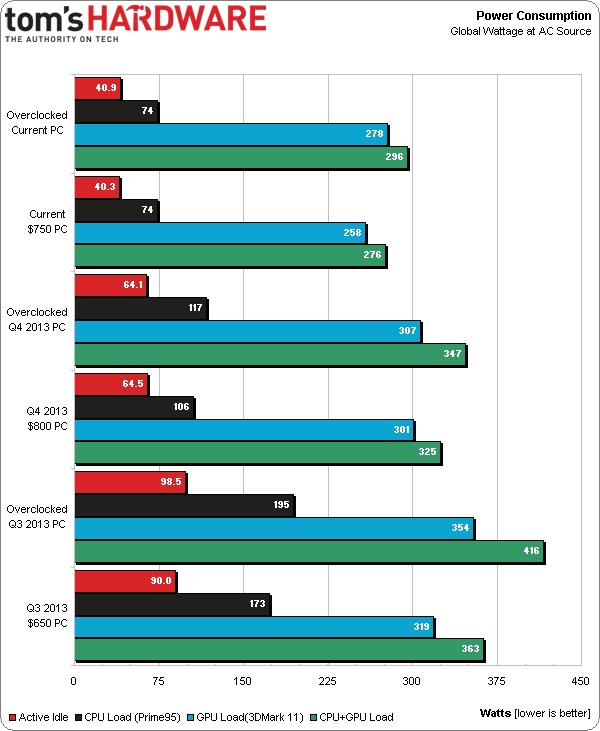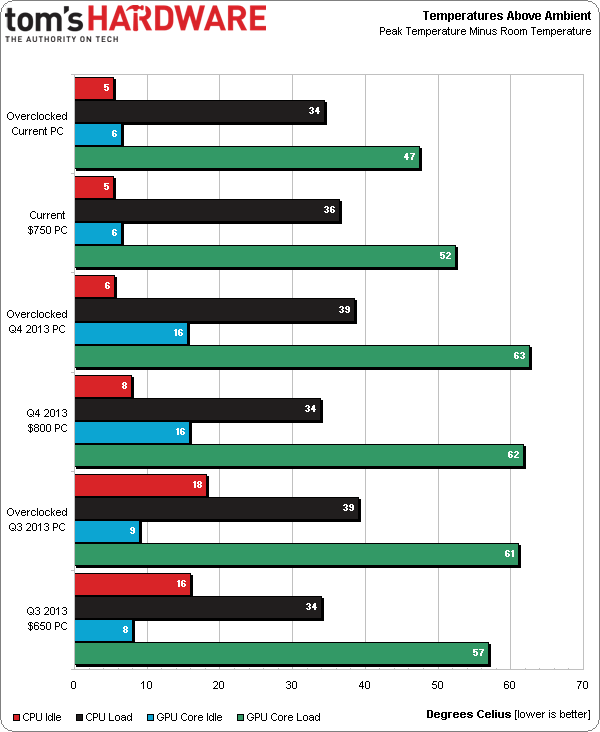System Builder Marathon, Q1 2014: The $750 Gaming PC
Power Consumption And Temperatures
Power-saving features are typically left on for each round of benchmarking. Only the overclocked $650 system didn't benefit from them. When it came to tuning the FX-6300's clock rates, I jumped into the firmware and disabled any setting that might negatively affect stability or performance consistency.
Sporting an efficient Haswell-based Core i3 processor and powered by an 80 PLUS Gold-rated power supply, my most recent effort sips power at idle and under host processing load. There's an overclocked, voltage-bumped GeForce GTX 770 in there, but still, peak draw from the wall remains under 300 W. You most certainly don't need the 600 W power supply recommended by Zotac. Our 450 W PSU has oodles of output in reserve.
Low power means that this quarter's PC is also the coolest-running in today's competition. Notice that CPU and GPU temperatures drop after applying an overclock. Simply, the CPU is left alone, and airflow increases by speeding up the cooling fans through Asus' firmware (from the Standard setting to Turbo). I also disabled control over the rear case fan by simply running it at 100% duty cycle. Finally, Zotac's thermal solution was quiet, so I created a custom fan profile to blow more air over the card and its components.
Of course, faster fans generate more noise. While this is by no means a quiet PC, it wouldn’t take much to pull its output down to a whisper. Surprisingly, overclocking didn't really add much noise since the 120 mm intake fan up front is the loudest. It doesn't vibrate, and is by no means obnoxious. But there is an unquestionable sound of rushing air. Needless to say, my fondness of the Line-M enclosure certainly diminishes when its bundled fans are running all-out.
Current page: Power Consumption And Temperatures
Prev Page Results: The Elder Scrolls V: Skyrim And Far Cry 3 Next Page Summarizing The Performance Of Three Gaming BuildsGet Tom's Hardware's best news and in-depth reviews, straight to your inbox.
-
blackmagnum This is the everyday Joe sort of gaming PC... cheap and workable. Why not Core i5 quad-core?Reply -
hmp_goose "The games we just added are unquestionably less processor-bound." This sounds like a major oversight, I fear …Reply -
ingtar33 nice build, and a good example of how even modern multi-threaded games are STILL at their heart primarily single or dual threaded games. We see this in BF4 most clearly, as the advantage of MOAR CORZ vanishes once you pass the 3rd core on the cpu... meaning a dual cored and hyperthreaded intel is still a viable gaming option; and though you can get an fx8320 for the same price as that i3, almost nothing truely makes use of 8 cores yet. I say yet, because the next gen game consoles will force games to become truly multithreaded in the future. Purhaps down the road the old piledriver chips will start to look like a great gaming value, but the situation today is still largely the same problem facing AMD 3 years ago... which is games simply don't really need MOAR CORZ. Not really anyway. I'm sure some people will have issues with using an i3, but really i think it was a fantastic read; and quite informative. Its important we keep things in perspective... and as things stand now you really don't need much more cpu power then a dual cored pentium or i3... or i guess quad core phenomII or piledriver fx.it all comes down to what you can afford to build around it.Reply -
lostgamer_03 The i3 was a bad choice, why not get an i5-3330 which is about the same in price and it offers 2 more fully enabled cores, which really would help in applications and the 'newer' games.The MOBO would also be cheaper as it is last gen.Reply -
de5_Roy the psu was a smart choice for the case, imo. modular cabling prevented the usual clutter seen in cases like these. the resulted unusually clean look of the inside. 80+ gold efficiency is also welcome. i don't think clean cable management can be measured in charts, but it's an added bonus.Reply -
pauldh That's what I thought too de5_Roy. Modular and 80 PLUS Gold was well worth spending an extra $15.Reply -
bemused_fred ReplyThe i3 was a bad choice, why not get an i5-3330 which is about the same in price and it offers 2 more fully enabled cores, which really would help in applications and the 'newer' games.The MOBO would also be cheaper as it is last gen.
When I first saw the parts list for this build, I expected myself to be in full agreement with you. I mean, can you imagine someone suggesting paring a GTX 680 with an I3? Ludicrous. They'd be laughed out the forums. However, looking at the benchmarks for the highest settings in 1920x1080 and 4800x900, I found there were 2 types of results
1. Those where the I3 and the GTX 770 build beat, or were within a few FPS of the I5 and R9-280X build:
Battlefield 3
Battlefield 4
Arma 3
Far Cry 3
2. Those where the I5 and R9-280X beat the I3 and GTX 770 build by a significant margin, but where all frame rates were well above 60FPS:
F1 2012
Grid 2
Skyrim
So, while overall performance percentage charts might put the I3 and GTX 770 behind the I5 and R9-280X behind in certain games, in a real-life setting, it seems that the I3 and GTX 770 is an equally good build. Which is really not what I was expecting.nalmost nothing truely makes use of 8 cores yet. I say yet, because the next gen game consoles will force games to become truly multithreaded in the future.
Citations desperately needed. The XBOX 360 had 3 hyper-threaded CPUs and the PS3 had a 7-core cell CPU, but this didn't push PC games during this period beyond dual cores. Indeed, as late as January 2012, Tom's hardware was finding it impossible to recommend any Quad-core AMD processors over intel Dual-core processors and as late as December 2012, dual-core Intel pentiums were taking the low-end recommendations, as they were still better at gaming at this point than 4-core AMD processors. Indeed, it wasn't until February 2013 that they reversed this recommendation, so any assumption that consoles having more cores will result in P.C. games using more cores doesn't really stand up to scrutiny, I'm afraid. -
pauldh ReplyThe i3 was a bad choice, why not get an i5-3330 which is about the same in price and it offers 2 more fully enabled cores, which really would help in applications and the 'newer' games.The MOBO would also be cheaper as it is last gen.
As explained on page 1, the whole idea here with this build was to spend less on the platform, more-than covering the premiums on graphics, RAM, and ODD vs. our last purchase.
Sure we'd go i5 if priced the same. But the -3330 is $60 more @ $190, just like the -3470 used last quarter. The -3350P saves $10 off that. H61 doesn't save much, starting $5-10 below H81, and then we'd give up capitalizing on the i5's limited overclocking. -
pauldh @bemused_fred - Yes, exactly! Good post.Reply
I was surprised to see i3 didn't yield any meaningful drop in minimum fps, at all! In fact, minimums often appeared GPU-bound, and the new GTX 770 rig won out, especially OC'ed. System bound at 70+ fps and up full-time in Skyrim or F1 2012 is hardly a loss, but an extra 3-8 fps consistently down low in ARMA III and Far Cry 3 could come in handy.
-
redgarl CPU choice is really overated with a single graphic card. The conclusion proves it. I would even stretch to go AMD to cut some money to fetch up two 750ti-760 GTX or 2 R7 graphic card.CF or SLI of two low tier graphic cards provide really good performances for a budget.Reply


